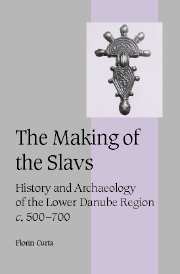Book contents
- Frontmatter
- Contents
- List of figures
- List of tables
- Acknowledgments
- List of abbreviations
- Introduction
- 1 Slavic ethnicity and the ethnie of the Slavs: concepts and approaches
- 2 Sources for the history of the early Slavs (c. 500–700)
- 3 The Slavs in early medieval sources (c. 500–700)
- 4 The Balkans and the Danube limes during the sixth and seventh centuries
- 5 Barbarians on the sixth-century Danube frontier: an archaeological survey
- 6 Elites and group identity north of the Danube frontier: the archaeological evidence
- 7 “Kings” and “democracy”: power in early Slavic society
- Conclusion: the making of the Slavs
- Appendix A
- Appendix B
- References
- Index
- Cambridge Studies in Medieval Life and Thought Fourth series
5 - Barbarians on the sixth-century Danube frontier: an archaeological survey
Published online by Cambridge University Press: 08 July 2009
- Frontmatter
- Contents
- List of figures
- List of tables
- Acknowledgments
- List of abbreviations
- Introduction
- 1 Slavic ethnicity and the ethnie of the Slavs: concepts and approaches
- 2 Sources for the history of the early Slavs (c. 500–700)
- 3 The Slavs in early medieval sources (c. 500–700)
- 4 The Balkans and the Danube limes during the sixth and seventh centuries
- 5 Barbarians on the sixth-century Danube frontier: an archaeological survey
- 6 Elites and group identity north of the Danube frontier: the archaeological evidence
- 7 “Kings” and “democracy”: power in early Slavic society
- Conclusion: the making of the Slavs
- Appendix A
- Appendix B
- References
- Index
- Cambridge Studies in Medieval Life and Thought Fourth series
Summary
Following the collapse of the Hunnic polity in the mid-fifth century, and the military and political recovery of the Empire in the late fifth and early sixth centuries, the northern frontier along the Danube became a key element of early Byzantine foreign affairs. The fifth, sixth, and seventh centuries were also a period of dramatic changes among the Empire's northern neighbors. For the making of the Slavic ethnie, these changes were particularly crucial. Justinian's defensive program on the Danube frontier triggered the social and political effects that led to the process of ethnic formation described in the last chapter. Equally important was the Empire's relationship with the neighbors of the Slavs, the Gepids, the Lombards, the Cutrigurs, and the Avars. The boom which has taken place in medieval archaeology over the last few decades has made this relationship far more visible than was possible on the basis of written sources alone. The purpose of this chapter is to examine the results of archaeological investigations and the problems raised by their interpretation. Emphasis will be laid upon the use of material culture for building group identity or creating symbols of power. I will first examine the evidence from the sixth-century Carpathian basin and neighboring regions, followed by a brief survey of Avar archaeology.
- Type
- Chapter
- Information
- The Making of the SlavsHistory and Archaeology of the Lower Danube Region, c.500–700, pp. 190 - 226Publisher: Cambridge University PressPrint publication year: 2001



